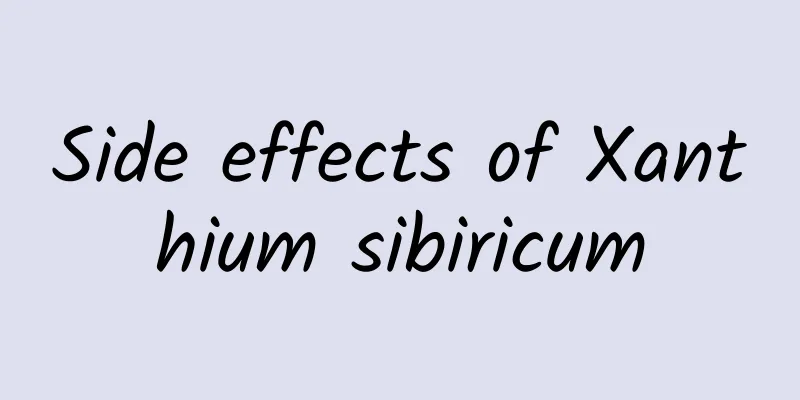Side effects of Xanthium sibiricum

|
Many people don’t know what Xanthium sibiricum is. In fact, Xanthium sibiricum is a herbaceous plant. It mainly grows in Heilongjiang, Anyang, Jilin and other places. Xanthium sibiricum is generally used as a Chinese herbal medicine, and has a good effect of dispersing cold and removing dampness. At the same time, it can also lower the blood sugar content of the human body and has a good therapeutic effect on the respiratory system, immune ability, etc., but Xanthium sibiricum also has side effects. So what are the side effects of Xanthium sibiricum? In addition to its good effects, Xanthium sibiricum also has certain side effects. Therefore, when taking Xanthium sibiricum, you must pay attention to its usage and dosage to prevent the production of toxins and other harmful effects on the body due to excessive intake of Xanthium sibiricum. Here I will introduce to you the side effects of Xanthium sibiricum. Xanthium sibiricum, also known as: Xanthium sibiricum; alias: Xanthium sibiricum, sticky head woman, lice horse head, Xanthium sibiricum, old Xanthium sibiricum, wild eggplant, Bi Zi, Taoist head, thorny eight naked, Cang Langzi, Mian Cang Langzi, Qiangzi naked, Qingji Zi, Qiangzi, Chitou Po, Hu Xanthium sibiricum, wild eggplant, pig ear, vegetable ear, Xanthium sibiricum, also known as magnetic head mang (chitou mang) in Cantonese. Xanthium sibiricum is an annual herbaceous plant of the Asteraceae family; the fruit with involucre of Xanthium sibiricum. Xanthium sibiricum is a commonly used Chinese herbal medicine with the effects of dispersing wind, removing dampness and opening the orifices. Distributed in Heilongjiang, Liaoning, Jilin, Inner Mongolia, Hebei, Anyang and other places. Italian Xanthium is an alien harmful species that affects agricultural and forestry production. In addition to being rich in oil compounds, Xanthium sibiricum also contains sterols, sesquiterpene lactones and water-soluble glycosides. It has corresponding pharmacological effects on blood sugar levels, cardiovascular system, respiratory system, immune system, etc. Side effects of Xanthium sibiricum The stems and leaves of Xanthium sibiricum contain substances that are toxic to nerves and muscles. After poisoning, the patient will experience general weakness, dizziness, nausea, vomiting, abdominal pain, constipation, difficulty breathing, irritability, cold hands and feet, and slow pulse. In severe cases, jaundice, nosebleeds, and even coma may occur, body temperature may drop, blood pressure may fluctuate, or there may be extensive bleeding, and eventually death from respiratory or circulatory failure. Precautions Do's and Don'ts: Do not take this medicine if you have headache or pain caused by blood deficiency. Toxic side effects: reduced activity, slow response to external stimuli, irregular breathing, extreme difficulty breathing before death, accompanied by paroxysmal convulsions. Pathological histological examination showed that liver damage was the most serious, that is, the main cause of seed kernel infusion poisoning was liver necrosis, and the convulsions caused by the subsequent brain tissue edema may be the direct cause of death. Clinically, excessive use of this product (more than 30g) or accidental ingestion of more than 10 Xanthium sibiricum fruits can cause poisoning, which usually occurs within 1 to 3 days, and the severity of the poisoning reactions varies. Generally, there are dizziness, headache, fatigue, mental depression, loss of appetite, nausea, vomiting, abdominal pain, diarrhea, or fever, facial flushing, conjunctival congestion, urticaria, etc.; in severe cases, irritability or drowsiness, coma, convulsions, arrhythmia, increased blood pressure, jaundice, hepatomegaly, liver damage, bleeding, casts and red blood cells in the urine, and urinary retention may occur. Hepatic coma, liver and kidney failure, or respiratory failure may occur due to massive necrosis of liver cells, leading to death. There have been reports of death from excessive use of Xanthium sibiricum fruits (children took 600 grams within two days). Poisoning treatment: 1. Induce vomiting, gastric lavage, and catharsis to expel toxins from the body as quickly as possible. After inducing vomiting, you can take warm milk or soy milk. If you have taken the medicine for more than 4 hours, you can take Glauber's salt orally, or use warm salt water enema to detoxify. However, use the above method with caution if you have gastric bleeding. 2. Hypertonic sugar is injected intravenously. Vitamin K can be injected intramuscularly to prevent bleeding. 3. Replenish fluids and vitamin C as appropriate. For patients with heart failure, urinary retention or pulmonary edema, the amount of infusion should be limited. 4. Patients with liver damage can take citric acid orally or inject methylthioamino acid intramuscularly to protect the liver. If the liver is obviously enlarged or jaundice occurs, intravenous drip of dextran can be added. 5. Patients with shock and circulatory failure should be treated with oxygen, dopamine, alamin, and intravenous infusion of hormonal drugs such as hydrocortisone or dexamethasone. 6. Treatment with Chinese herbal medicine. 1) Grind the purple gold ingot into a thin paste, take half or one ingot each time, twice a day, and reduce the dosage for children. It has the effects of detoxification, diuresis and opening the orifices; 2) 50g of licorice, 10g each of polygala and sanyutan, 15g of adenophora, and 1.5g of panax notoginseng (with water). Decoction in water, and take orally in case of gastrointestinal bleeding; 3) For those who are unconscious or comatose, give Zhibaodan, Zixuedan, or Angong Niuhuangwan as appropriate; 4) Acupuncture treatment. After reading the above detailed introduction to the side effects of Xanthium sibiricum, I believe that you have already gained some knowledge and understanding. It is not advisable to take an overdose of Xanthium sibiricum. Generally, taking more than 10 pieces may cause poisoning, and symptoms such as nausea and abdominal pain may occur. Therefore, when taking Xanthium sibiricum, it is best to take the medicine under the guidance of a doctor, which is the safest way. |
<<: The efficacy and function of Zuogui Pills
>>: Side effects of licorice tablets
Recommend
The efficacy and function of Trachelospermum erythrorhizon
In our lives, Trachelospermum jasminoides has att...
The efficacy and function of hollyhock
Only when we understand the main ingredients of a...
The French plane tree is not a sycamore and is not native to France.
I heard that the "French plane trees" i...
What are the effects and functions of Angelica and Astragalus and how to eat them?
Although the current living standards are constan...
When is the best time to take Panax notoginseng powder?
Panax notoginseng powder is both a health product...
What are the recipes for black hair medicinal wine?
In addition to the natural condition, if we want ...
Side effects of bathing with boiled mugwort leaves
Mugwort is a widely used Chinese medicinal materi...
Special Chinese medicine for lowering creatinine
Speaking of high creatinine, many people may feel...
Lamb, tofu, seafood... Do we have to stop eating these "irritating foods" if we get hurt?
After an injury, you always want to take good car...
How to drink wolfberry in water
There are many nutritious things in our lives. Th...
What are the medicinal values of wild ginseng?
Wild ginseng is a common Chinese medicinal materi...
Treating cervical spondylosis with Phellodendron
The health pillow made of Phellodendron chinense ...
After the war between humans and cockroaches, some cockroaches lost their "love"...
"The orioles are singing on the island in th...
The efficacy and function of ram horns
As people's living standards improve, they pa...









